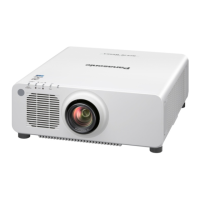Chapter 4 Settings — [PROJECTOR SETUP] menu
ENGLISH - 165
Setting the communication condition of the <SERIAL OUT> terminal
1) Press as to select [RS-232C].
2) Press the <ENTER> button.
f The [RS-232C] screen is displayed.
3) Press as to select [(OUT) BAUDRATE].
4) Press qw to switch the item.
f The items will switch each time you press the button.
[9600]
Select the proper speed.[19200]
[38400]
5) Press as to select [(OUT) PARITY].
6) Press qw to switch the item.
f The items will switch each time you press the button.
[NONE]
Select the parity condition.[EVEN]
[ODD]
Setting the response
1) Press as to select [RS-232C].
2) Press the <ENTER> button.
f The [RS-232C] screen is displayed.
3) Press as to select [RESPONSE(ID ALL)].
4) Press qw to switch the item.
[ON] Returns the response when an ID is designated as ALL.
[OFF] Does not return the response when an ID is designated as ALL.
5) Press as to select [GROUP].
6) Press qw to switch the item.
[A] - [Z]
Controls multiple projectors simultaneously by sending the ID of RS-232C. You can set groups from
[A] to [Z]. The projector responds when the ID of RS-232C matches the setting.
7) Press as to select [RESPONSE(ID GROUP)].
8) Press qw to switch the item.
[ON] Returns the response when an ID is designated as GROUP.
[OFF] Does not return the response when an ID is designated as GROUP.
Note
f When [INPUT SELECT] is set to [DIGITAL LINK], communication using that serial terminal can be used only when the corresponding device
(such as the optional DIGITAL LINK output supported device (Model No.: ET‑YFB100G, ET‑YFB200G)) is connected to the <DIGITAL LINK/
LAN> terminal.
f When transferring logos via the optional DIGITAL LINK output supported device (Model No.: ET‑YFB100G, ET‑YFB200G), setting for “NO
SIGNAL SLEEP” of the DIGITAL LINK output supported device should be set to “OFF” to avoid interruption of communication.
f When [INPUT SELECT] is set to [DIGITAL LINK], communication speed for input is xed to 9 600 bps and the parity is xed to “NONE”.
[REMOTE2 MODE]
You can set the <REMOTE 2 IN> terminal.

